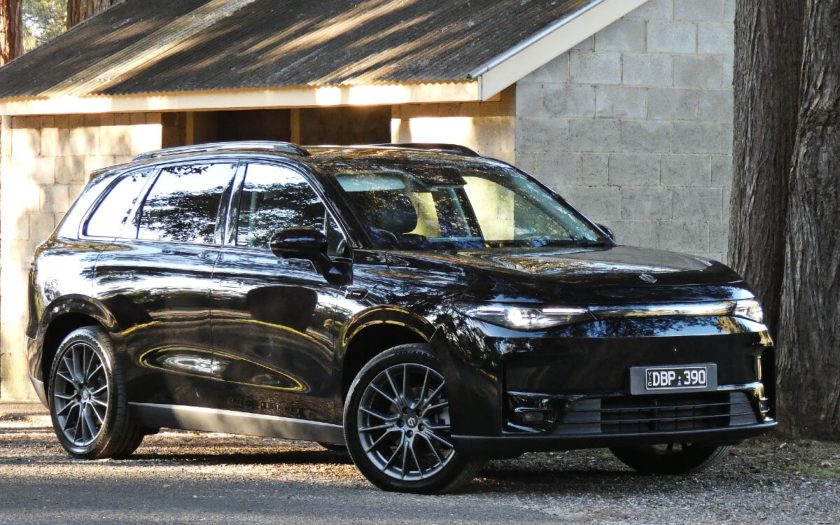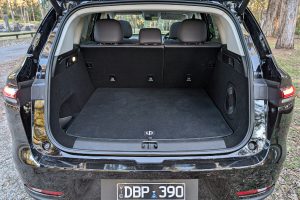Chris Riley tests the 2025 Leapmotor C10 Design mid-size crossover SUV with pricing, specs, ride and handling, safety, verdict and everything the over-50 driver needs to know.
Summary: The Leapmotor is an intriguing new arrival on the market, and seems to have borrowed a lot of its designs and features from Tesla. It is quite efficient, but uninvolving. And the driver safety warnings are really annoying.
2025 Leapmotor C10 Design mid-size crossover SUV
Pricing: $45,880 (Style, plus on road costs), $49,888 (Design, plus on road costs)
Options: any colour other than white $990
Warranty: Seven-years, 160,000 kilometre, eight-years/160,000 battery pack
Safety: five-star ANCAP (2024 )
Engine: single electric motor
Battery: 69.9kWh Lithium Ferro Phosphate
Service intervals: 24 months or 20,000km
Power: 160kW
Torque: 320Nm
Transmission: single-speed, rear-wheel drive
Body: 4739mm (long); 1900mm (wide); 1680mm (high)
Build country: China
Kerb weight: 1995kg
Towing capacity: 1500kg
Luggage storage: 581L (all seats upright), 1410L (second row folded)
Wheels: 18-inch alloy (Style), 20-inch alloy (Design)
Tyres: 235/55 R18 (Style), 245/45 R20 Dunlop e Sport Maxx (Design)
Spare wheel: puncture repair kit
Ground clearance: 180mm
Turning circle: not stated
Claimed energy consumption: 18.5kWh/100km
Claimed range: 425km
Claimed charging time: 30 minutes (DC charger up to 84kW, 30 to 80 percent), 11 hours (home charging, zero to 100 percent)
Energy consumption on test: 16.0kWh/100km (480km)
seniordriveraus consumption on test: not tested
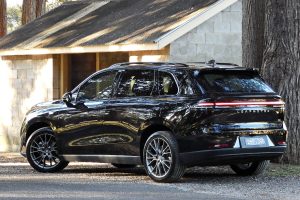
[review]
Leapmotor is a Chinese startup based in Hangzhou that specialises in electric vehicles.
It hasn’t been around long and only started selling cars here from the beginning of the year, starting with the C10 we’re testing.
The company currently produces seven models from a small city car through to a six seat SUV called the C16 that is based on the same platform as the C10.
In 2023, Stellantis acquired a 20 percent stake in the company for approximately 1.5 billion euros, with plans to roll out Leap product internationally.
Stellantis is of course the mothership for the Fiat, Alfa, Jeep, Ram, Dodge, Maserati, Opel and Vauxhall brands as well as the French PSA Group which includes Peugeot and Citroen.
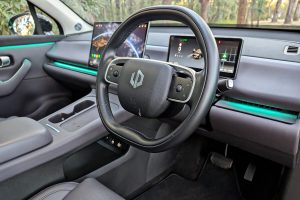
What’s it cost?
C10 is offered in two grades, Style and Design, priced from $45,888 and $49,888 respectively, plus-on road costs.
A plug-in hybrid, the C10 REEV, is also available for $2000 less, grade for grade.
There are two interior trim choices – dark grey and dark green.
Any colour but white adds $990 to the price.
Style features 18-inch alloys, pop-out door handles, artificial leather trim, two zone climate air with energy saving heat pump, power-adjust front seats and a fixed panoramic glass roof with electric sunshade.
The lights are all LEDs, there’s adaptive cruise control, auto lights and wipers, auto high beam, rear parking sensors and heated exterior mirrors.
Design adds larger 20-inch Trident sporty wheels, rear light bar with animations, multi-colour interior ambient lighting, rear privacy glass, silicon leather, heated and cooled front seats and a heated steering wheel and a power-operated tailgate.
Both get a manual-adjust rear view mirror.
Inside, C10’s Smart Digital Cockpit offers a clean, uncluttered layout, if a little spartan.

The infotainment system features a large, dominant 14.6-inch high-definition touchscreen, as well as a 10.25-inch driver instrument panel.
It is complemented by five-way scroll buttons on the steering wheel and dual-zone voice recognition for verbal commands.
Intelligent rhythmic ambient lighting works in harmony with the surround audio system when using Bluetooth audio and embedded apps.
Bluetooth, voice control, in-car Wi-Fi, AM/FM and DAB+ digital radio are offered, plus built-in navigation.
Note however that the C10 does not include Apple CarPlay or Android Auto, either wired or wireless and the company has no plans to add either.
Sound comes from a 12-speaker, 840W 7.1-channel surround audio system, with four audio modes: Enjoy, Surround, Theatre, and Dynamic.
Over-the-air updates are supported and the Leapmotor app provides remote access to the car.
In addition, drivers can log into embedded apps like Spotify, TikTok, and Zoom via the central vehicle display.
These apps run independently of any smartphone connection thanks to an inbuilt 4G connection.
C10 gets a full five stars for crash safety, with seven airbags, 360-degree birds-eye camera, and automatic emergency braking (AEB).
The LEAP Pilot Intelligent Driver Assistance System features 12 ADAS sensors and 17 ADAS functions.
Autonomous emergency braking includes Car-to-Car, Vulnerable Road User, Junction & Crossing, Backover and Head-On functions.
There’s also lane support with lane keep assist (LKA), lane departure warning (LDW) and emergency lane keeping (ELK), blind spot detection (BSD) and an advanced speed assistance system (SAS) with a speed sign recognition system.
You’ll soon discover the annoying Advanced Driver Distraction Warning (AADW) Camera keeps watch from the front pillar.
C10 is covered by a seven-year/160,000km warranty plus eight-year/160,000km on the high-voltage battery pack.
Service intervals are 24 months or 20,000km.
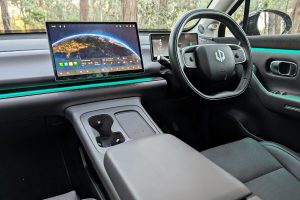
What’s it go like?
The long, rounded profile reminds us of the Mitsubishi Outlander from a few years ago.
C10 is a mid-sized five-seater that is 4739mm long, with a 2825mm wheelbase and weighs in at 1995kg.
The spacious cabin boasts a flat floor with oodles of rear legroom, plenty of boot space and underfloor storage to stash charge cables.
However, you won’t find a spare wheel in the boot – just a puncture repair kit.
First row seats are large and comfortable, with an impressive 937mm legroom and 951mm for the second row.
The better quality Oeko-Tex leather in the Design has been tested for harmful substances.
Rear seats passengers get air-con vents, two USB ports, map pockets, door bins and a fold down armrest.
The interior offers 26 storage spaces and 180-degree flat-fold seating, with a console box for storage of smaller items, as well as concealed USB ports and a wireless charging pad.
There’s 581 litres of cargo space with all seats upright, expanding to 1410 litres when the second-row seats are folded.
The cargo area has a maximum depth of up to 1820mm and a maximum width of 1100mm.
C10 is powered by a single rear-mounted electric motor that drives the rear wheels.
It delivers 160kW of power and 320Nm of torque, together with a 69.9kWh lithium ferro-phosphate (LFP) battery pack.
Energy consumption is a claimed 18.5kWh/100km, while maximum range is 425km under the WLTP standard.
We clocked up 480km at a rate of 16.0 kWh/100km, better than claimed but still not fantastic.
To give this some context, a Tesla Model Y RWD uses just 11.7 kWh/100km.
Cell-to-Chassis (CTC) technology sees the battery cells integrated into the chassis, freeing up space, lowering the centre of gravity and apparently boosting driving range.

There are four drive modes, three levels of regenerative braking, and three separate steering modes, with one-pedal driving available through the touchscreen (take your foot off the accelerator and the car will come to a stop).
- ECO – Smooth acceleration, strong regenerative braking, comfortable steering
- Chill – Stable acceleration, low regenerative braking, comfortable steering
- Sport – Powerful acceleration, strong regenerative braking, sporty steering
- Custom – Customise acceleration, regenerative braking and steering mode to driver’s preference
The dash from zero to 100km/h takes 7.5 seconds and it has a top speed of 170km/h.
With a maximum DC charge rate of up to 84kW, recharging from 30 to 80 percent can be achieved in about 30 minutes.
Not sure where they get that 30 to 80 percent from; most manufacturers provide figures for 10 to 80 percent and, in the case of the C10, that takes 48 minutes.
AC charging from zero to 100 per cent, on the other hand, will take just over 11 hours with an onboard charger capable of 6.6kW.
Fully charged the car showed a range of 471km when we picked it up.
Five days later the battery was almost dead empty with just 320km under our belt.
It took us just over 11 hours and 20 minutes to recharge a 22kW AC EVSE, showing a range of 477km afterwards.
There is a large disparity between what the car estimates (477km), what the manufacturer claims (425km) and what it actually returns in real world driving (320km).
Included as standard are both mode 2 and mode 3 charging cables and Vehicle-to-Load capability.
C10 is different in some ways from any other EVs you may have had the opportunity to drive.
The key is an access card that must be held up to the driver side exterior mirror to lock or unlock the car.
Alternatively, you can set up your mobile phone to access the car, using NFC technology. Once inside the card must be placed on the wireless charge pad to start the car. And once running, it can be removed.
Leapmotor has gone for a Swedish minimalist look, with an absence of physical knobs or buttons.
The large central touchscreen acts as the control centre for virtually everything.
Even the steering wheel is sparsely decorated and we were forced to consult the manual to find out how to activate cruise control.
As it turns out, one must pull down on the gear lever, located on the right side of the steering column, as if you were putting the car into Drive.
Not sure we like the dual-purpose approach, but they got it through to the ‘keeper.
The button on the end of the stalk is reserved for Park which also engages the electric parking brake.
Where are the air vents? What about the door locks? What about the external mirrors? What do the buttons on the wheel do?
It’s all one big magical mystery tour that leads back to the central screen in the middle of the dash.
Floating shortcuts are provided for some features like air conditioning, but they are difficult to operate on the move.
The smaller instrument panel lacks customisation and is easier to read in dark mode, but at some point, reverted to light mode.
Apart from the Marie Kondo approach to design, C10 for the most part is unremarkable – functional rather than fun to drive.
And, given its price and target market, that’s not entirely unexpected.
Throttle response is good if not great, or perhaps we should say pedal response. Punch it and the C10 gets moving.
But braking can be unexpected, sometimes pulling up sharply, at other times requiring more pedal effort.
The driver assist systems are intrusive and become irritating after a while, with plenty of beeps and tugging on the steering wheel.
It makes you wonder who they build these cars for. Obviously not confident Aussie motorists who know how to steer and stay in their own lane.
Also of note, we discovered it is easy to accidentally brush the raised window switches without knowing, only to start wondering where the draught was coming from a few minutes later.
And the front and, we assume, rear seatbelts cannot be deployed from the get-go if the car is parked on a slight rise. Huh?
The navigation can show the driving range of the car on a map as well as point out where the nearest public charger is located, but overlooked a bank of six 300W Tesla superchargers just down the road from us.
At the same time, it was aware of other Tesla chargers that were located further away.
Not exactly confidence-inspiring.
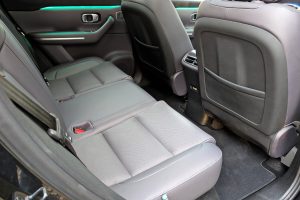
What we like
- Relatively cheap
- Premium audio standard
- Spacious interior with generous legroom
- Rear air outlets
What we don’t like
- Brakes not progressive
- No speed camera warnings
What over-50s need to know
The Leapmotor C10 is an interesting addition to the electric scene.
The more so because it is a relative newcomer with no ties to established brands, that is until Stellantis bought a chunk of the company a couple of years ago.
This means no preconceptions about what a car should be and it shows in their different approach to things.
As an SUV it works. As an electric vehicle it works. And if the price works, it could be time to do the electric boogaloo.
At the same time, there is room for improvement and refinement.
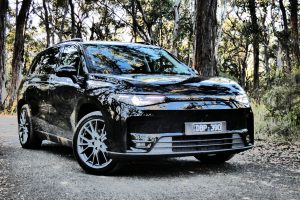
seniordriver comments
Leapmotor is very much an unknown quantity in Australia, but being owned by Stellantis provides some reassurance.
The absence of both Apple CarPlay and Android Auto will put some intending buyers off, and there are no plans to introduce either, so there’s no point waiting for a change of heart.
Once again, the overly intrusive Advanced Driver Distraction Warning will probably drive you to distraction. Even wearing sunglasses can set it off.
The variance from quoted figures for consumption and range is a concern. Even at its best (18.5kWh/100km) it isn’t particularly inspiring. It gets worse when the onboard computer is telling you there’s a predicted range of 477km when fully charged, only to see the battery give up the ghost after just 320km Cue severe range anxiety!
Like many of its ilk, there’s a minimum of physical buttons or controls, meaning a frustrating wade though the on-screen menus to access many functions, including such regularly adjusted things as air vents, door locks and external mirrors.
